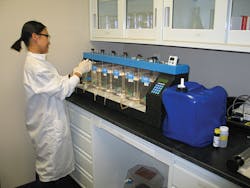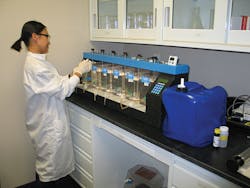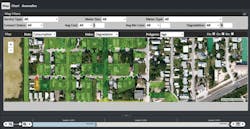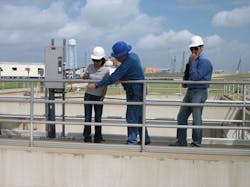Seven Tips to Optimize Mid-sized Water Utility Operations
By Jacques Brados and Gary Wong
Small to mid-sized water utilities face daunting challenges. They must operate at a high level of efficiency and productivity while relying on short-term fixes - versus long-term solutions - to keep aging infrastructure operable. For many water and wastewater municipalities, short-term fixes, including repairing broken pipes on an as-needed basis, are the result of a lack of available funding for long-term, proactive solutions. Furthermore, with funding limitations and scale-down issues, small and mid-sized utilities cannot invest in the mainstream technologies available to larger utilities that would provide sophisticated data collection and analysis solutions needed to maximize efficiency, reliability and performance.
Recent research by Black & Veatch Strategic Directions confirms those concerns. When US water utilities were recently asked about the economic, regulatory, technological and stakeholder pressures they face, the top four responses - an aging water and sewer infrastructure, ability to fund capital programs, managing capital costs, and justifying capital improvement programs - centered around managing the operation and maintenance of a rapidly aging infrastructure in today’s economy. Further complicating the task is a rapidly aging workforce and difficulty recruiting engineering and IT specialists.
A difficult obstacle that mid-sized water utilities encounter as they attempt to solve these problems is gathering data and deriving value from narrow information silos across the organization. Information from SCADA systems, GIS, maintenance systems, and billing data are typically available only to a very small group of users.
As a result, the process of turning operational data into actionable intelligence is often lengthy and difficult. To collect data on significant events such as a water main break, operators need to track SCADA system data, acquire access to maintenance data, or investigate possible construction projects going on near the break. Acquiring this data can take weeks. Investigations that require business data as well, such as how much it costs to process a million gallons of water or water losses due to leakage or theft, can take even longer.
A data infrastructure, such as the OSIsoft PI System, offers a foundation for collecting and merging data from disparate sources. With it, water utility operators and engineering personnel can collect, manage, analyze and contextually present real-time operational data across the organization. That, in turn, allows plant managers, engineers, operations and maintenance staff to easily access and share information to proactively solve problems.
Moreover, a growing number of complex solutions are now available to analyze the data once it is collected. As an example, Black & Veatch offers ASSET360™, an analytics platform that hosts their data and uses solutions that calculate and monitor key performance indicators, asset health and system performance. These analytic solutions allow water utility operators to analyze asset reliability, service quality, efficiency, performance, regulatory compliance and risk, and provide insightful and timely decision-making towards optimized planning and performance. Accordingly, as utilities become more familiar with the capabilities of these solutions, they are increasingly transitioning from point solutions to a more enterprise-wide focus. They are shifting toward forward-looking, predictive analytics and focusing more intently on the business value of these data collection and analysis efforts.
Large water utilities have become more proactive addressing reliability and maintenance challenges, avoiding costly facility shutdowns and optimizing energy usage to reduce costs. At the core of their progress are condition-based monitoring, new technologies and analytical solutions. Yet, small to medium-sized water utilities struggle to take advantage of the same capabilities.
Small to mid-sized water utilities can use these seven tips to help them reap the many benefits of mainstream technologies that large utilities leverage. Begin by identifying the critical elements of your infrastructure, including the age and condition of each asset, and then:
- Establish a robust asset management framework to provide a structure to optimize asset management.
- Familiarize yourself with the PAS 55 and ISO55001 standards. These standards are crucial to the development and implementation of frameworks.
- Develop a clear strategy to optimize asset performance. As part of that plan, ask these questions: What data do I have, which parts would be valuable to integrate, and what areas of my operations would benefit from analytics and contextual data? Who needs real-time data for proactive decision-making? What metrics are going to be the most impactful for meeting both short-term and long-term goals?
- Try starting with a pilot program. Sometimes trying to maximize data quality by combining too many data sources all at once (including SCADA, lab, maintenance, and customers) can be a monumental task. Addressing short-term goals and connecting one or two sources can help create momentum and provide the support needed to achieve long-term goals from results-oriented stakeholders.
- Match the complexity of your solution to the complexity of the problem. Look to use mathematical models and operational knowledge to build solutions that capture the value from current data sources before adding additional instrumentation.
- Provide open data access across all groups within the utility by interconnecting data sources and building dashboards around KPIs. Bonus tip: People need to understand data sets in ways that make sense to their roles. Understand how different teams consume data so that they receive data insights that are in the right context, at the right time and with actionable meaning.
- Roadmap long-term goals. Identify critical data for point solutions, and build a plan around aggregating data and analytics solutions to unify departments and improve efficiencies.
About the Authors: Jacques Brados is the regional I&C manager for Black & Veatch. He has over 20 years of technical and managerial experience providing SCADA and Instrumentation & Control management in water, pharmaceutical, manufacturing, and nuclear energy. Gary Wong is principal, global water industry, for OSIsoft. He brings a wealth of international experience in providing sustainable, strategic and cost-effective business solutions to the water and wastewater industry.
More WaterWorld Current Issue Articles
More WaterWorld Archives Issue Articles



